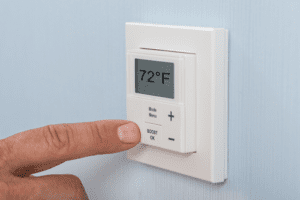The cycling on and off of HVAC equipment is such a regular part of our lives at home and at work that it is easy to take it for granted. Most people don’t pay much attention to these systems until something is wrong. One of the most essential parts of an HVAC setup isn’t the air handler or the compressor, though they are critical, too; instead, it is the thermostat or temperature control unit. If you’ve ever wondered how an AC or furnace knows when it’s time to go to work, you’ve tried to answer the question “how does temperature control work?” This quick breakdown will make it easy to understand how these systems work, why they’re important, and what’s on the cutting edge.
Why Temperature Control is Important
 Without a reliable way for your HVAC system to sense the temperature of the air in a key spot within the building, there would be no way for it to tell when it should stop or start to run. If a temperature control system does not have the proper placement, it can also cause issues that result in cycles that are too long or too short. Either scenario could cause excessive wear and tear on your furnace and air conditioning equipment.
Without a reliable way for your HVAC system to sense the temperature of the air in a key spot within the building, there would be no way for it to tell when it should stop or start to run. If a temperature control system does not have the proper placement, it can also cause issues that result in cycles that are too long or too short. Either scenario could cause excessive wear and tear on your furnace and air conditioning equipment.
However, there is more to temperature control than the basic sensing of the air. More advanced systems, such as the VAV or “variable air volume” setup, use mechanical systems to modulate the temperature of individual spaces within a building. This method is also called zoned heating and cooling, and with the right equipment, it can be the key to valuable gains in efficiency with a corresponding reduction in strain on the system.
How Does Temperature Control Work? The Basics of Thermostats
At the heart of any temperature control system is the thermostat. There are many kinds of thermostats, and older homes may still have units that feature bimetallic strips or mercury switches. However, most modern thermostats are entirely digital, relying on some clever computer calculations rather than a potentially dangerous element such as mercury. These thermostats measure the amount of resistance present in an electrical circuit and uses that information with some fancy formulas to determine the air temperature. If it’s above or below the target threshold, the thermostat will send commands to the HVAC equipment to make the appropriate adjustment. If you’re still wondering “how does temperature control work?”, the answer comes into play when you begin to connect multiple thermostats to one central control unit.
More Complex Systems Allow for Fine-Tuned Control
Zoned heating and cooling is an important system in many businesses and in some larger homes where occupants may want more control over their temperature. Without it, huge HVAC systems would be necessary to be able to keep up with the demand generated by such a large structure. With temperature control systems in place, though, customizing climate control room by room is a simple matter.
Some systems are purely mechanical. There may be one central thermostat for controlling the temperature, for example. Each room can then adjust the amount of airflow in order to change the desired temperature. Others automate this process, opening and closing fins within the ductwork automatically to regulate the flow of air into a room with the help of a small computer. In the most complex VAV setups, warm air from a heat pump mixes with air from the AC to reach the specific temperature desired in any given room.
The Benefits of More Accessible Temperature Control
Why would anyone take the time to set up a system such as this outside of buildings? There are several excellent reasons to consider a more granular temperature control system:
- Lower energy bills. When you aren’t heating or cooling rooms that don’t need it, your system will not need to run as frequently, helping to conserve energy.
- Improve individual comfort. End complaints about how one end of the building is always cold and the other hot. These setups help to achieve a more reliable balance between the two extremes.
- Prolong equipment life. Corresponding with the lower energy bills, fewer equipment operating hours during peak heating and cooling seasons will translate into a longer lifespan for your investment.
Discover New Options with an HVAC Contractor
Answering the question of “how does temperature control work?” is not as easy as it first seems. Whether it is a residential home or an office high-rise, though, these systems are fundamental for the efficient operation of HVAC equipment. With a greater emphasis on sustainability and efficiency in today’s world, zoned systems and more robust temperature control setups continue to gain in popularity. Could a change be right for your home or business? To find out, connect with a licensed and well-referenced HVAC contractor in your area. Let them know you’d like to know more about your system and how to explore making gains in energy efficiency for your property today.

